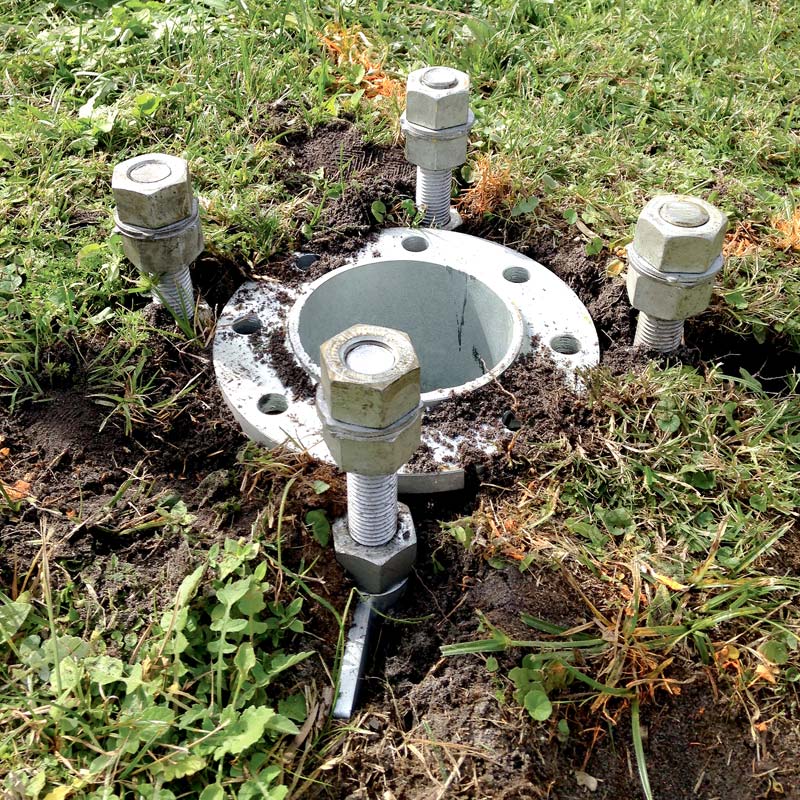General
The performance of the star finned screw pile involves a complex soil/structure interaction. The geotechnical considerations which need to be addressed are:
- Shear strength of the soil surrounding the fins and shaft;
- Presence of hard layers at shallow depth;
- Piles in sloping ground;
- Soil loss around fins/reactive clay soil; and
- Soil disturbance due to trenching works.
It should be noted that these considerations are applicable to all piling types resisting lateral loads. The lateral capacity of the star finned pile system is considered to be high when compared to uniform concrete or steel shaft piles.
The orientation of the four fins is such that a larger passive wedge of soil is mobilised in front of the fins. Piles extracted after testing by excavation were found to have a cylinder of compacted soil around the shaft.
We consider that this is probably due to the result of of the soil being compacted between the helix and the fins during installation, as the pile installation is a displacement process. This ‘equivalent pile diameter’ should also increase the geotechnical capacity of the finned pile system.
Shear Strength of Soil
Critical design loading on the finned piles is the result of an instantaneous wind gust. Under wind load conditions the soil response should be in an undrained condition for both cohesive and cohesionless soils. The field trials have been carried out in soils with an undrained shear strength of at least 50kPa.
If the fins are installed in soils with undrained shear strengths less than 50kPa, then the deflections of the system under wind load may exceed the elastic limit of the soil. If the fins (or any other pile system) are installed in soft to very soft (say Cu <20kPa), then ultimate rotational failure and excessive non-recoverable deflections may occur.
If it is necessary to install lighting colmns over soft ground, then a site-specific star finned screw pile system could be designed. This may include deeper fins and a longer shaft than those provided for that standard pile series, or the deisgn of a pile group.
In the event that non-recoverable deflection of the foundation and lighting column occur, the column can be re-leveled using the leveling bolts provided on top on the fins. If the deflections are such that they exceed the limitations of the leveling bolts, then a jacking system can be used to straighten the pole and foundation. This may include installing a temporary finned pile adjacent to the foundation of concern and jacking the pole back into its original position.

Pile penetration Lengths
The piles need to be installed to their design length with the fins fully submerged in soil. This is to ensure global stability and to fully dissipate the applied moment and shear force down through the fins and shaft. If a hard layer or weathered rock is encountered above the design founding level, then pre-boring may be required.
Sloping Ground
The passive resistance of soil is reduced when the ground falls away from the pile. In the case of star finned screw piles supporting lighting columns with a high bending moment and minimal shear, the pile will tend to be rotated down into the ground rather than deflected laterally.
This behavious was observed during field trials. In additonal there are four fins resisting the applied force, thus at least two fins will be on the ‘uphill side’ of the pole where full passive resistance can be assumed.
We consider that the finned piles installed on sloping ground, the lateral capacity should not be adversely affected for slopes up to 1V:3H. For piles installed in steeper sloping ground, other than rock slopes, increased fin length would be required to provide equivalent lateral capacity.
Soil Loss Around Fins
The star finned pile system relies on soil around the fins immediately below ground level to provide passive resistance. It is normal practice to ignore the upper 600mm to one pile diameter to allow for soil loss due to erosion and reactive clay shrinking away for the pile.
Most of the light poles will be installed adjacent to road pavements or footpaths with a sealed surface. This protection system should eliminate erosion and minimise soil moisture content change. For those finned piles installed where no surface protection system is provided, an assessment of the potential for soil loss around fins should be made.
In clay soils in low to moderate plasticity, both erosion and shrinkage should not occur. In cohesionless soils on gentle slopes with an adequate shear strength erosion should not occur.
In steep sloping sites with cohesionless soils, and on reactive clay sites, some form of protection to minimise soil loss would be necessary. This may include geo-fabrics around the fins, a concrete pad around fins or replacing clays with compacted granular fill.
Soil Disturbance Due to Trenching Works
After the star finned pile is installed it is necessary to then excavate a narrow trench in front of the fins to install the electrical cable. The presence of the cable slot is common to any foundation system for a lighting column.
The backfilled cable trench should not adversely effect the performance of the star finned screw pile system. The width of the fins and the large soil mass mobilised in front of the fins under wind loading.
In some cases there may be larger backfilled service trenches near the pile foundation. We consider than the presence of these trenches should not adversely effect the behaviour of the foundation provided that they are backfilled with compacted fill.
The Copper Grounding Rod and the in Ground Star Fin Screw Pile
If the steel and copper are electrically connected and immersed in an electrolyte (wet soil is an example) a galvanic cell is set up to the dissimilar metal couple. The steel becomes anodic and an oxidative process (corrosion) takes place in the steel surface. The copper becomes cathodic and a reductive process takes place at the copper surface.
The standard electrode potentials are often quoted for the two metals and the resulting 0.78 volts given as the cell driving force.
Fe Fe²+ + 2+ = 0.44V
Cu²+ + 2+ Cu = 0.34V
Fe + Cu²+ Cu + Fe²+ = 0.78V
This is an over simplification as this is only true if the copper is immersed in a copper containing electrolyte.
In soil the actual electrode process of the copper surface will be oxygen reduction or hydrogen evaluation. Even though copper surfaces have a high affinity for oxygen the voltage or a cell generated is never likely to exceed 1.5V and would rarely approach this figure.
The problem is avoided if the star finned screw pile is electrically insulated from the copper earthing rod or the light pole’s base plate. Since the insulation only has to break the galvanic circuit it is only required to insulate against the 0.78V expected as maximum in the cell.
Stray Current Corrosion
Stray current effects and galvanic effects are a completely different phenomena. Stray current corrosion occurs in buried steel which is close to D.C. electrical currents.
The induced currents in the steel can lead to the set up of corrosion cells. In the case of the star finned screw pile the copper earth rods earths a A.C. system so stray current is not an issue.

